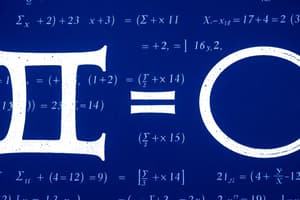Podcast
Questions and Answers
Which of the following statements about summation notation is true?
Which of the following statements about summation notation is true?
- The summation of a constant with the index set is equal to the product of the constant and the number of terms in the index set. (correct)
- The summation of the product of a constant with a variable is equal to the product of the constant with the summation of the variable.
- The summation of the sum of two terms is equal to the sum of the individual summations.
- The summation of a constant with the index set is equal to the constant.
What does the index of summation represent?
What does the index of summation represent?
- The upper limit of summation
- The lower limit of summation
- The value of the variable for the ith observation (correct)
- The collection of consecutive integers from the lower limit to the upper limit of summation
What is the upper limit of summation?
What is the upper limit of summation?
- The collection of consecutive integers from the lower limit to the upper limit of summation (correct)
- The index of summation
- The value of the variable for the ith observation
- The lower limit of summation
Which property of summation allows us to distribute a constant outside the summation?
Which property of summation allows us to distribute a constant outside the summation?
What does the term of the summation represent?
What does the term of the summation represent?
Flashcards are hidden until you start studying
Study Notes
Summation Notation Overview
- A concise mathematical notation representing the sum of a sequence of terms.
- Summation notation is typically denoted by the Greek letter Sigma (Σ).
Index of Summation
- Represents the variable of summation; it indicates the position of each term in the sequence.
- The index often starts at a specific value and increments by one until it reaches the upper limit.
Upper Limit of Summation
- The maximum value that the index of summation can take.
- It determines the total number of terms to be included in the summation.
Distributing a Constant
- The property of summation that allows a constant factor to be factored out is known as the linearity of summation.
- This property states that c * Σa_n = Σ(c * a_n), where c is a constant and a_n is the term being summed.
Term of the Summation
- Represents each individual element or component being added together in the summation.
- The term is typically defined by the index, such as a_i for i = 1 to n, indicating that each term corresponds to a different value of the index.
Studying That Suits You
Use AI to generate personalized quizzes and flashcards to suit your learning preferences.




